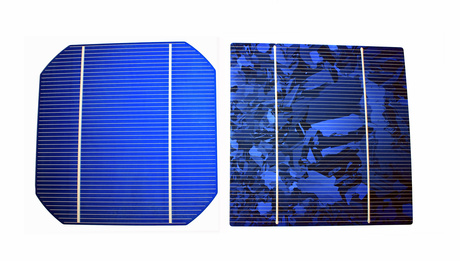
When solar cells get hot they lose efficiency. Researchers have developed a coating that keeps cells cooler.
Contrary to popular thought, heat reduces solar cell efficiency. As the cells heat up from the direct glare of the sun, their efficiency in converting light into electricity drops markedly. Depending on the system used and the location, losses can reduce output up to 10 to 25 percent.
This conundrum has vexed the industry for many years. After all, solar cells need the sun to work and this generates heat. So how to solve this problem and increase the light-to-electricity efficiency of solar cells?
Enter a team of researchers from Stanford University who have developed a transparent coating for the cells. The film keeps the cells cool as they heat up under the sun. Made of patterned silicon, the secret to this remarkable film is that, while it allows visible light to pass, it also absorbs and even emits the infrared rays, the source of thermal radiation.
According to Shanhui Fan, professor of electrical engineering at Stanford:
“Solar arrays must face the sun to function, even though that heat is detrimental to efficiency,” Fan said. “Our thermal overlay allows sunlight to pass through, preserving or even enhancing sunlight absorption, but it also cools the cell by radiating the heat out and improving the cell efficiency.”
In tests conducted by the Stanford researchers, the film coating allowed visible light to pass through while reducing the temperature of the cell by up to 5 degrees Celsius. This means efficiency in solar cells can be improved by over one percent. This increase in cell efficiency would result in “…a significant gain in energy production” according to a Sept 21 Stanford press release.
Based on technology previously developed by the team, the next step is to develop a method that will make the film affordable for solar panel manufacturers at a commercial scale. There are a number of options available although the researchers are already looking at nanoprint lithography, a common technique used for producing nanometer-scale patterns.
“That’s not necessarily the only way,” said research associate Aaswath P. Raman, a co-first-author of the paper. “New techniques and machines for manufacturing these kinds of patterns will continue to advance. I’m optimistic.”
While at the experimental stage at present, great gains in boosting solar cell efficiency will be made if the team can develop the film coating at an affordable level.

 RSS - Posts
RSS - Posts



Why don’t they just put automotive cooling film on them? Every new car in the Middle East comes with it as standard – http://www.solargard.com/au/window-films/car-tinting/film-line/ultra-performance